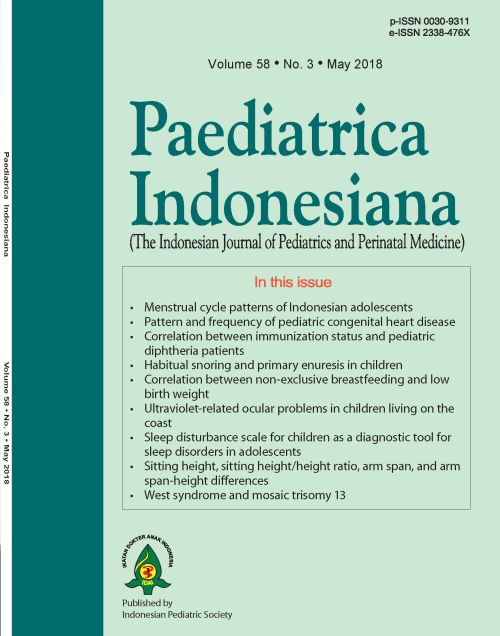Correlation between non-exclusive breastfeeding and low birth weight to stunting in children
Abstract
Background Indonesia is ranked fifth in the world for the problem of stunting. Stunting in children under the age of five requires special attention, due to its inhibiting effect on children’s physical and mental development. Stunting is caused by several factors, one of which is breastfeeding. Stunting has been associated with several factors, one of which is non-exclusive breastfeeding.
Objective To determine the correlations between non-exclusive breastfeeding and low birth weight to stunting in children aged 2-5 years.
Methods This case-control study was conducted in October to November 2016 in multiple integrated health service clinics (posyandu) in Sangkrah, Surakarta, Central Java, Indonesia. Subjects were children aged 24-59 months who visited the posyandu and were included by purposive sampling. Children classified as stunted were allocated to the case group, whereas the children classified with normal nutritional status were allocated to the control group. Parents filled questionnaires on history of exclusive breastfeeding, child’s birth weight, maternal education, and family socio-economic status.
Results Of the 60 subjects, the control group had 30 normal children and the case group had 30 stunted children. Multivariate analysis by logistical regression test revealed statistically significant correlations between stunting and non-exclusive breastfeeding (adjusted OR for exclusive breastfeeding 0.234; 95%CI 0.061 to 0.894), as well as low birth weight (adjusted OR 10.510; 95%CI 1.180 to 93.572) This value implies that exclusive breastfeeding is a protecting factor against stunting, which means exclusive breastfeeding is able to decrease the prevalence of stunting in children under the age of five.
Conclusion In children aged 2-5 years, the histories of non-exclusive breastfeeding and low birth weights are significantly correlated sith stunting.
References
Millenium Challenge Account-Indonesia. Stunting dan masa depan Indonesia. [Internet]. 2015; [cited 2016 May 18]. Available from: www.mca- indonesia.go.id
Kikafunda JK, Walker AF, Collett D, Tumwine JK. Risk factors for early childhood malnutrition in Uganda. Pediatrics. 1998;102:e45.
Lestari ED. Diagnosis and nutrition management on children wth stunting. In Lestari ED, Wulandari A, Editor. Pediatric Clinical Updates in daily Practices. CME Dept of Child Health, UNS-Moewardi Hospital. 2018. p.18-34.
Badan Penelitian dan Pengembangan Kesehatan Kementerian Indonesia. Riset Kesehatan Dasar. Jakarta: Kementerian Kesehatan RI; 2003. p. 212-213
International Food Policy Research Institute. Global Nutrition Report 2014 : Actions and Accountability to Accelerate the World's Progress on Nutrition. Washington DC: International Food Policy Research Institute; 2014. p.9. .
WHO. Global Strategy on Infant and Young Child Feeding. Switzerland: World Health Organzation;2013. p.15-24.
Cai X, Wardlaw T, Brown DW. Global trends in exclusive breastfeeding. Int Breastfeed J. 2012;7:12.
Ballard O, Morrow AL. Human milk composition: Nutrients and bioactive factors. Pediatrics Clinics of North America. 2013;60:49-74.
Murti B. Desain dan Ukuran Sampel untuk Penelitian Kuantitatif dan Kualitatif di Bidang Kesehatan . Yogyakarta: UGM Press; 2010. p.119.
Hendra A, Miko A, Hadi A. Kajian stunting pada anak balita ditinjau dari pemberian ASI eksklusif, MP-ASI, status imunisasi dan karakteristik keluarga di Kota Banda Aceh. JKIN. 2010;6:169-184.
Aldy OS, Lubis BM, Sianturi P, Azlin E, Tjipta GD. Dampak proteksi air susu ibu terhadap infeksi. Sari Pediatri. 2009;11:167-73.
Nirwana, A. Kandungan dan manfaat ASI dan susu formula. Yogyakarta: Nuha Medika; 2014. p. 125-6.
Mbuya MNN, Chidem M, Chasekwa B, Mishra V. Biological, social, and environmental determinant of low birth weight and stunting among infants and young children in Zimbabwe. Zimbabwe: Zimbabwe Working Papers; 2010. p.11
Adair LS, Guilkey DK. Age-specific determinants of stunting in Filipino children. The Journal of Nutrion. 1997;127.
Rahman MS, Howlader T, Masud MS, Rahman ML. Association of low-birth weight with malnutrition in children under five years in Bangladesh: do mother’s education, socio-economic status, and birth interval matter?. PLoS One. 2016;11:0157814.
Kusharisupeni. Peran status kelahiran terhadap stunting pada bayi: sebuah studi prospektif. Jurnal Kedokteran Trisakti. 2022;23:73-80.
Ramli, Agho KE, Inder KJ, Bowe SJ, Jacobs J, Dibley MJ. Prevalence and risk factors for stunting and severe stunting among under-fives in North Maluku province of Indonesia. BMC Pediatrics. 2009;9:64.
Chaudhury RH. Determinants of dietary intake and dietary adequacy for pre-school children in Bangladesh. Bangladesh Institute of 23 Development Studies. [Internet]. 1984; [cited 2016 May 26]. Available from: http://archive.unu.edu/unupress/food/8F064e/8F064E04.htm
Nasikhah R, Margawati A. Faktor Risiko Kejadian Stunting pada Balita Usia 24-36 Bulan di Kecamatan Semarang Timur. Journal of Nutrition College. 2012;1:176-184.
Girma W, Genebo T. Determinants of The Nutritional Status of Mothers and Children in Ethiopia. Calverton:ORC;2002. . [Internet]. 1984; [cited 2016 May 26]. Available from: https://dhsprogram.com/pubs/pdf/fa39/02-nutrition.pdf.
Copyright (c) 2018 Endang Dewi Lestari, Faraissa Hasanah, Novianti Adi Nugroho

This work is licensed under a Creative Commons Attribution-NonCommercial-ShareAlike 4.0 International License.
Authors who publish with this journal agree to the following terms:
Authors retain copyright and grant the journal right of first publication with the work simultaneously licensed under a Creative Commons Attribution License that allows others to share the work with an acknowledgement of the work's authorship and initial publication in this journal.
Authors are able to enter into separate, additional contractual arrangements for the non-exclusive distribution of the journal's published version of the work (e.g., post it to an institutional repository or publish it in a book), with an acknowledgement of its initial publication in this journal.
Accepted 2018-06-04
Published 2018-06-08













